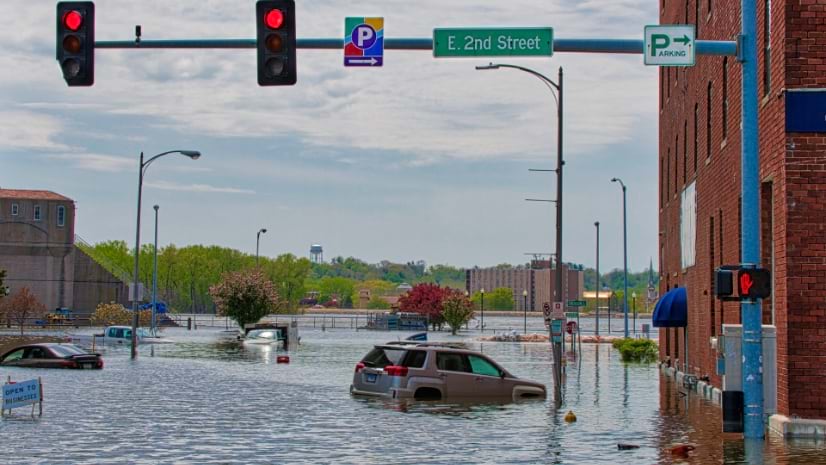

August 13, 2024

“What have I got, where is it going, and what am I going to need?”
In an emergency, the answers to these questions are vital. And they are a constant concern for Brian Payne, Scott County Emergency Management Agency director in Iowa.
Where Scott County sits in America’s Midwest means that its approximately 175,000 residents experience their share of extreme weather. There have been tornadoes, floods, and derechos, even droughts and the occasional earthquake, and there’s a nearby nuclear power station. These risks require the county’s emergency management agency to be prepared for anything.
This need to be prepared for anything—when and where it might happen—has brought Payne and his team much closer with the county’s geographic information system (GIS) analysts over the years.
As deadly tornadoes carved a path through Iowa in late May, the teams were following reports in near real time. If the twisters had neared Scott County, the teams would have been ready to mobilize, providing life-saving information to first responders. Instead, they got lucky. The storm system changed directions.
The relationship between emergency managers and the county’s GIS analysts deepened last November in preparation for a biennial simulation of a radiological event. It’s a massive one-day exercise involving four counties across two Federal Emergency Management Agency (FEMA) regions, two states, the nuclear power plant, and several hundred people. During the disaster simulation, FEMA representatives evaluate how agencies react.
Members of the emergency management agency and the GIS team collaborated to create the county’s Situational Awareness Experience app. Built using ArcGIS developer tools, the application has grown beyond nuclear radiation simulations to enable better awareness of any high-risk event—be it a tornado or a closely watched election.
“You could have the best plans in the entire world, but you can’t control everything,” Payne said. “Being adaptable on the fly but controlling the things you can prior to that—this tool does that.”
Following the partial meltdown at a nuclear reactor on Three Mile Island in Pennsylvania in 1979, FEMA was put in charge of leading off-site emergency planning and preparedness activities in the case of a radiological event. The work often involves plume modeling to determine the distance that radioactivity may travel. Knowing the location and trajectory of radiation clouds influences evacuation zones and helps multiple agencies coordinate their response.
Before developing its new Situational Awareness Experience application for emergency preparedness exercises, Scott County relied on a web app that was helpful, but it did not connect to other information essential for a radiological exercise. For example, health department officials would need information about vulnerable populations. Law enforcement would need to see road closures and safety perimeters. A county executive would need to see the evacuation areas and gauge the evacuation rate to determine who should shelter in place.
Hunting down necessary information became a time-consuming challenge, particularly for Scott County’s three-person GIS team: Ray Weiser, Darrell Inskeep, and Breanna Pairrett.
Invariably, during the simulation of a radiological emergency, the GIS team would be busy editing and updating data, and somebody would ask for a list or a data export.
The team needed a way to display information that others in the Emergency Operations Center (EOC) wanted to see.
Pairrett was hired in mid-2023 as a dedicated GIS analyst for the Emergency Management Agency. In November, she worked with Inskeep and Weiser to expand the county’s tool. They wanted to feature more statistics, more numbers.
“We like maps and we know how to read them, but not everybody does,” Pairrett said. “We needed something that we could also interact with more and add data quickly to. It would be a much more pleasant experience for everyone, and we [could] get information relayed to other people within the EOC during any kind of event.”
With input from Payne and others on his team, including Molly McKee and Jim Hawkes, the GIS team developed a tool that would display all the information in one place. In the EOC, the information was displayed on multiple screens.
“People were up by those TV screens, writing stuff down or pointing at it, talking to their individual teams,” Pairrett said. “We might have gotten asked a couple questions, I can’t even really remember. It worked so smoothly.”
In its evaluation of Scott County’s performance during the exercise, a FEMA evaluator noted the county’s use of GIS displays positioned in the EOC showing critical information updated in near real time.
“This was an extremely valuable tool to allow EOC staff to quickly view key information related to the emergency and is a best practice,” the evaluator wrote. “I have seen many EOCs use GIS products. However, the integration of multiple data sources with displays of the zones that are updated in near real time sets Scott County apart from other EOCs that I have evaluated over the past several years.”
Weiser, Scott County’s GIS manager, attributed the county’s preparation advancements to the trust and cooperation that have grown over the years between the Emergency Management Agency and the GIS team.
“Everything you see today really grows out of this repeated interaction and participation in these exercises,” he said. “They’re expressing needs, and we’re asking questions, and they’re asking questions, and it’s just an iterative process where every time we get together, we learn, and it results in better preparation.”
That was especially true in 2019. “Between January 1 and May 31, the longest span of consecutive days without rain or snow was five days in April,” Payne said. The ground had been saturated with water before it froze. City staff braced for Mississippi River flooding to reach record levels. That’s when Payne approached the GIS team members for the first time, asking if they could make a flood inundation map. What would it look like if the flood level gauge—which had never surpassed 22.3 feet—reached 26 feet, for example? Where was that water going to go?
“I realized that they welcomed dumb questions from emergency management people like me saying, ‘Hey, what about this? What would this look like? Can we do something like that?'” Payne said.
To those questions, and any others, Inskeep said the GIS analysts never say no.
They developed their own inundation map, which included a curious inland spot the GIS determined was likely to flood. When a levee was breached, the curious little spot filled with water. It turned out to be the location of a drain they had been unaware of.
Payne, impressed at the accuracy, became a fervent fan of both the GIS team and the technology.
In August 2020, a derecho tormented Scott County with wind and thunderstorms, leading to power outages that lasted for several days during sweltering heat. Payne and the GIS team worked on gathering information from federal sources to learn about vulnerable residents. Eventually, Payne and the team surveyed residents themselves to find out who might use items, such as a wheelchair or an oxygen tank, that are among 68 categories of health-care needs. The next time that type of event happened, the team wanted to be able to more quickly identify places, such as assisted-living communities, where the county’s most vulnerable populations live.
At the time, the team didn’t have a good way to capture that data, store it, and leverage it. Now, the information is kept on a secure server at the county, ready to be accessed in the team’s Situational Awareness Experience app. When needed, the data can be pushed to first responders, sending them to specific addresses. Responders can be more prepared knowing how many people in an evacuation zone might need medical assistance and where they are.
Payne’s long-term goal is to share direct access to the Situational Awareness Experience with Scott County’s first responders. If firefighters are on their way to a commercial fire, for example, they would know what’s inside and—if it’s a chemical—how it’s stored and whom to contact, as well as be able to make rough evacuation zone estimates.
Having that knowledge at hand within a moment’s notice when emergency strikes is why the GIS team is among the very first to join the EOC staff alongside the county’s public information officers.
“[The GIS team and the public information officers) are the two things we call in simultaneously every single time. Period. No questions asked, because everything is about, ‘What have I got? Where is it going, and what am I going to need?’” Payne said. “And everything is about public communication and then communication to the first responders. It’s imperative to be successful in any response, no matter what it is.”
Learn more about how GIS helps monitor and respond to emergencies.


